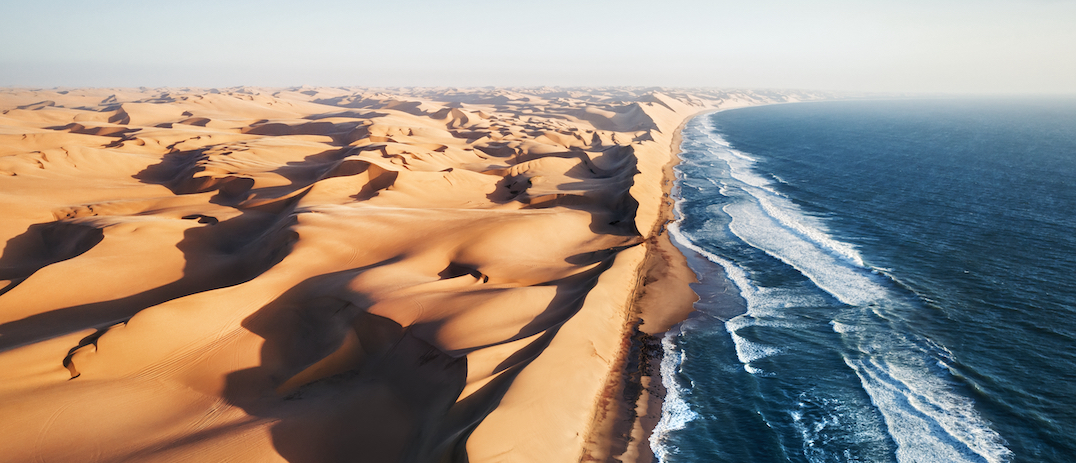
A wild and protected coastline
The coastal strip is home to the beautiful towns of Henties Bay, Swakopmund and Walvis Bay, and the small settlement of Wlotzkasbaken. Its incredible national parks include Dorob National Park – proclaimed to protect sensitive environmental areas – which extends between the Swakop and Ugab rivers, while the Skeleton Coast Park covers the area north of the Ugab River up to the Kunene River, protecting the northern third of Namibia’s coastline. In 2013, the Namib Sand Sea – stretching from the Kuiseb River southwards to the northern boundary of Tsau//Khaeb National Park – achieved World Heritage Site status, making it Namibia’s second UNESCO World Heritage Site. The Atlantic Coast spans the entire western border of Namibia.
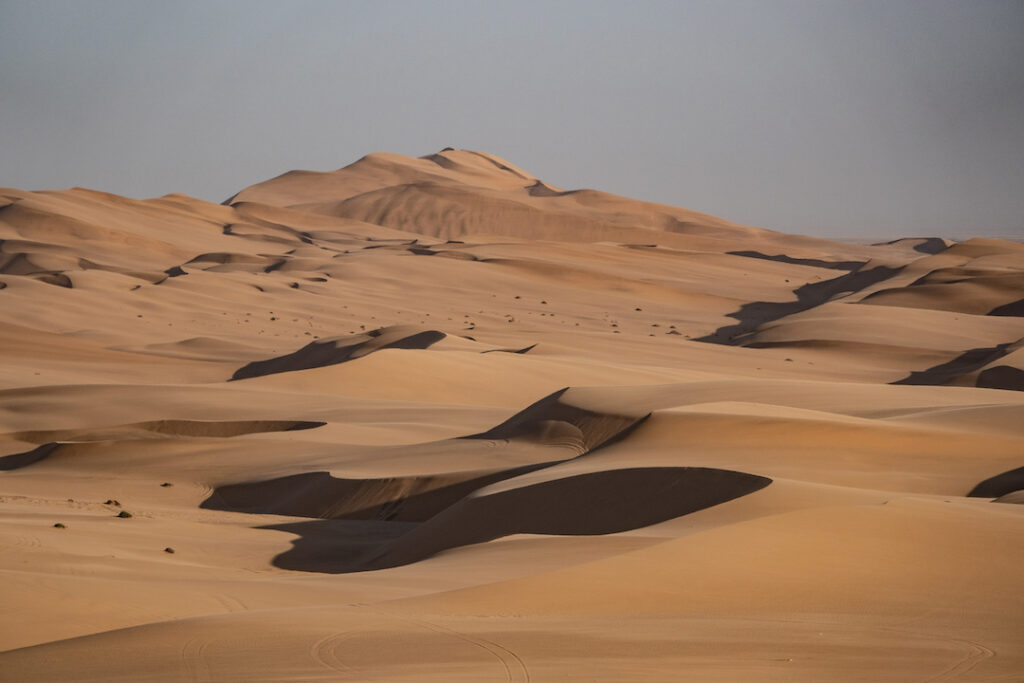
The Namib Sand Sea is a UNESCO World Heritage Site, one of only two in Namibia with the other being Twyfelfontein.
DOROB NATIONAL PARK
To protect the most frequented coastal area against damage caused by off- road driving, the stretch of coastline between the Kuiseb Delta and the Ugab River – eastwards from the low- water mark of the Atlantic towards the boundary of the Swakopmund district – was proclaimed a national park in 2008, elevating the status of the West Coast Recreational Area (WCRA) to that of national park, and proclaiming it as the Dorob National Park. It includes the Walvis Bay Lagoon – a RAMSAR site – but excludes the municipal areas of Walvis Bay, Swakopmund and Henties Bay, as well as Wlotzkasbaken. The Namibian coastline is a haven for numerous unique plants, animals and birds. A special feature of international interest is the occurrence of extensive lichen fields. Over a hundred lichen species have been recorded in the Namib Desert. A symbiotic composition of an algae and a fungus, lichens are dependent on coastal fog for survival. The continued existence of this intriguing form of desert life is a matter of serious concern to environmentalists, as lichens are extremely slow growing and are destroyed when vehicles driving offroad tread on them. The 200-km stretch of coastline between the Swakop and Ugab rivers is renowned for its excellent angling potential. Over the years popular angling spots along the coast were identified by dedicated anglers and named to indicate their distance from Swakopmund. To drive in specially demarcated off-road areas, drivers must have a permit, which is issued free of charge and can be obtained from Ministry of Environment, Forestry and Tourism (MEFT) offices in Swakopmund (064 40 4576) and Walvis Bay (064 20 5971). A free information pamphlet is also available from the above-mentioned offices, as well as from coastal information offices.
SWAKOPMUND
Swakopmund is much-loved by Namibians as a welcome respite from the heat in the interior. It is also popular among visitors because of its old- world charm and relaxed atmosphere. Founded in 1892 during German colonial rule, it served as the territory’s main harbour for several years.
Today this quaint town between the desert and the sea is enhanced by lush green lawns, elegant palm trees and carefully tended public gardens. It has a wide choice of hotels, guesthouses and restaurants, and several coffee shops selling traditional German cakes and pastries. The coast with its desert hinterland offers many options, both for adventure and for relaxation.
Just before reaching Swakopmund from the interior, enclosed in a small glass-fronted structure, visitors can view the Martin Luther ‘steam-ox’ imported from Germany in 1896 to transport goods between the town and other settlements. When the steam tractor became irretrievably bogged down in the sand, it was dubbed Martin Luther, because of Luther’s historic statement in 1521, “Here I stand, may God help me, I can go no further.” The venue has a museum, toilet facilities and curios for sale.
Quaint architecture from a bygone era adds to the place-out-of-time atmosphere of Swakopmund. When approached from the interior, domes, turrets and towers on the skyline appear like a hazy desert mirage. Much of the distinct German colonial character has been preserved and today many of the town’s old buildings house shops, offices and other services.
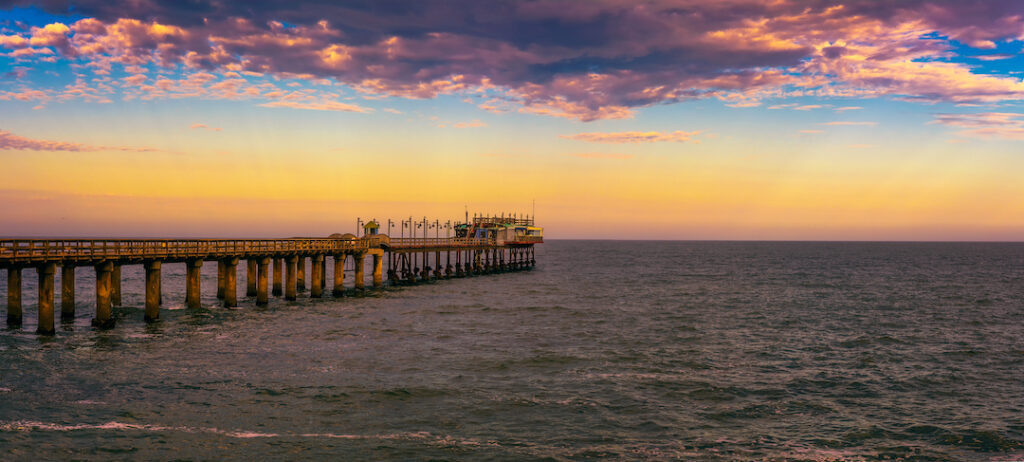
The Swakopmund Jetty, originally built in 1905 during the German colonial era.
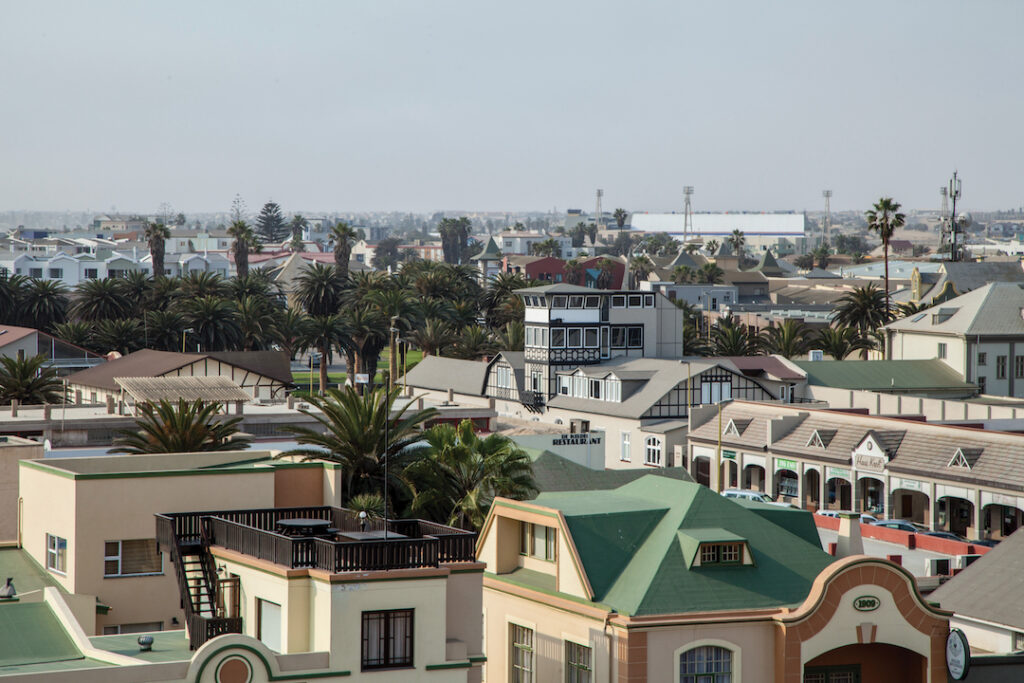
The Swakopmund environs
Camel and horse rides are offered a short distance from the town. Cars and 4×4 vehicles can be hired to embark on day trips or safaris into the desert. Beach-buggy excursions to the beach, dunes or hinterland also include sundowner tours, hunting and fishing safaris, and dune and tyre surfing. Flights over the town and the shipwrecks along the coast can be expanded to include charter flights further afield, while specialisedsafaris take visitors to see the dune landscapes and plants of the desert.
Reputable air-charter companies take visitors on short flips over the dunes and to further destinations.
On the beachfront next to the National Marine Information & Research Centre in Strand Street is the Swakopmund Aquarium where the ocean comes to life for visitors. Its main feature is a transparent tank with a glass walk-through viewing tunnel and a number of additional viewing panels, placed at different angles. The oval tank holds 320,000 litres of seawater. The tank contains a variety of fish, including spotted shark, sand shark, kabeljou, steenbras and galjoen, and many other organisms. The theme depicted in the tank is a typical west-coast reef with related flora. There are also 17 smaller viewing tanks, one of them in the form of a tube. Special features are the so- called touch pools containing typicalintertidal flora and fauna. A new touch tank was added during the upgrades, hosting stingrays, and the top floor has been renovated into a welcoming educational environment for children. The complex also houses an auditorium, with seating for approximately 120 people. It is used for conferences, lectures, slide shows and other presentations and is fully equipped with audio-visual, interpretation and other amenities. Feeding takes place daily at 15:00. The aquarium is closed on Mondays, Christmas Day and New Year’s Day, but is open all other days from 10:00 to 16:00.
Woermann House, built in 1905 to accommodate the Damara and Namaqua Trading Company and sold in 1909 to Woermann Brock, houses the Swakopmund Arts Associationand Public Library. The Woermann Tower, which can be accessed at specified times, affords a panoramic view of desert and sea. It has a platform from which, in earlier times, a flag was flown whenever a ship of the Woermann Line was sighted at sea.
The Living Desert Snake Park in Libertina Amadhila Street hosts a variety of interesting creatures for the whole family to enjoy. The historical Otavi-Bahn building served as the terminal for the mining railway line. The goods shed next to this building, built in 1911 and called OMEG-Haus, is a national monument.
The old barracks, known as Die Alte Kaserne, were built by the German colonial government in 1905 to house the German Engineer Regiment responsible for the construction of the jetty and the railway line into the interior. It is now a youth hostel based on the concept of the International Youth Hostel Federation. The privately-owned Hohenzollern-Haus, embellished by a frieze of angels and lions and originally built in 1905 to accommodate visiting aristocracy from Germany, at one time functioned as a house of ill repute. Today this striking building serves as an apartment house, while the Prinzessin Rupprecht-Heim, built in 1902 to operate as a hospital, is now a guesthouse.
The Kaiserliches Bezirksgericht (magistrate’s court) was built in 1901. Since independence the building has been serving as a summer residence for the President of Namibia. Next to it are the gardens of the Marine Memorial, commemorating marines who died in the 1904/5 Herero uprising. The elaborate Railway Station Building, erected in 1901, was transformed into a luxury 75- room hotel and entertainment centre, complete with casino, cinema, bar and restaurant. Resembling a Bavarian villa with its ornamental exterior, the Swakopmund Jail is often mistaken by visitors for a hotel. One of the town’s most prominent landmarks, the Swakopmund Lighthouse, was completed in 1903, as was the harbour breakwater known as The Mole, today the southern boundary of Swakopmund’s main tourist beach.
The Evangelical Lutheran Church, consecrated in 1912, is the second- oldest of its kind in the country. Closely associated with the history of the town, is the Kramersdorf building (1912), with its architectural value lying in the wide, flat wooden bow. It traditionally served as a private residence, school hostel, and summer house. Today it is privately owned.
Another historical landmark is the Old Iron Jetty, originally built in 1905 during the German colonial era. The jetty was frequented especially by anglers and tourists, but gradually fell into disrepair. Major repairs were done in 1983 when 17 pairs of the iron pillars were encased in concrete. In 1997 the Save-the- Jetty Fund was established and in 1998 the jetty was closed because it was deemed unsafe. Following a major N$ 3.7 million refurbishment in 2006, the front section was reopened to the public. In 2010 the back section was reopened and now includes an oyster bar and restaurant, with an observation deck on top.
Laid out in stone in 1915, a selection of the regimental badges from the South West Africa Campaign can be viewed 27 km east of Swakopmund. The campaign was launched by the Union of South Africa on the Germans stationed in South West Africa at the outbreak of WWI. More regimental badges can be seen about 46 km east of the town. Similar badges and patterns, also laid out in stone, can be found between Swakopmund and Trekkopje, along the railway line. Other interesting sites in the area are small fortifications, the trenches, and the cemetery at the Trekkopje station.
A 27-million-year-old fossil, meteorite chunks, fossilised wood, and jawbones of our human ancestors mingle with Spanish coins, restored ox wagons and turn-of-the-century drawing rooms in the Swakopmund Museum, a small but comprehensive institution with displays ranging from natural history, mineralogy and botany to historical and ethnological dioramas. A walk through the museum, founded by Dr Alfons Weber in 1951, takes you travelling through time, from ancient earth forming to a more recent colonial past. Situated on the seafront between avenues of palm trees, this treasure house holds a multitude of interesting artefacts. A large airy hall houses a People of Namibia exhibition with information on the diverse and distinct population groups of Namibia. Baskets, headdresses, amulets and ostrich eggs fill the many display shelves. The Emil Jensen Herbarium exhibits Namib flora. The entrance of the museum faces the Atlantic Ocean and the Mole which shelters a popular swimming beach. The Alte Brauereistube café has been added to one side of the building.
The Public Library has amenities for visitors, while the well-known reference facility known as the Sam Cohen Library comprises some 6 000 volumes and an impressive collection of historic photographs. This includes the renowned 2 000-title Africana collection of the late Ferdinand Stich.
The archives, housed in the same building, give visitors access to a unique collection of newspapers dating from 1898 to the present day.
The Mole and adjacent Palm Beach provide a popular if somewhat cold swimming area, with the lee of the Mole serving as a launching place for yachts and other pleasure crafts. The contestants in the annual triathlon, which takes place in December, end their swim at The Mole. Rossmund is a grass golf course with a unique desert setting located some 10 km inland from Swakopmund. The well laid-out 18-hole golf course has been described as one of the most scenic and unusual in Southern Africa, with herds of free-roaming springbok in the surroundings adding to its charm. The annual horse show, known as the Reitturnier, brings the best horses and riders in Namibia together. Other sports are skydiving, duneboarding, sand-skiing, paragliding, surfing and windsurfing, yachting, and angling from the beach or a boat. There are motocross and 4×4 rally facilities on the outskirts of the town. The latest development in town is the multi-million Swakopmund Indoor Sport Centre, also known as The Dome Swakopmund, the only multi-sport complex of its kind in Africa. Spanning over 7 000 m2 and comprising five storeys, the centre accommodates more than 40 different sport codes and their supporting facilities and services. The Dome also houses a hotel, restaurant, bar, shops and a health and wellness centre.
Accessible from Sam Nujoma Avenue and Hendrik Witbooi and Tobias Hainyeko streets is the Brauhaus Arcade with its many small specialist shops offering handmade leatherwork, arts and crafts, furnishings and Namibian textiles, and embroidery. The Brauhaus itself is a popular German-style restaurant and bar with seating outside, popular for serving large beers in boot-shaped glasses. The main outlet for Art Africa is also situated here, selling quirky crafts and fine African tribal art, amongst others. Another branch is situated in Tobias Hainyeko Street, flanked by a corridor of craftsmen and the Art Africa Garden Café. The Woermann Brock Arcade, accessible from Sam Nujoma Avenue and Hendrik Witbooi Street, features regular shops and several outlets selling Namibian products. It leads into the Ankerplatz complex, also accessible from Sam Nujoma Avenue. In Tribes Trading in the adjacent Woermann Mall, ‘Made in Swakopmund’ T-shirts are painted as you watch. Featuring animals in bright, primary colours, these make colourful children’s gifts. Next to the arcade on Sam Nujoma Avenue, Small World is an outlet for unique handmade Namibian jewellery and leather goods. Semi-precious stones, ostrich eggshell beads, Owambo ekipa buttons and Himba metal beads are fashioned into stylish and original necklaces, bracelets and belts. Also in Sam Nujoma Avenue, Ikhoba offers a range of well-crafted embroidered goods in vivid colours, produced by 400 women of various ethnic groups as part of the Ikhoba Textiles Farm Project. Meme Ikhoba, situated in Hendrik Witbooi Avenue, is another outlet for these goods. In the same street is Fleissige Biene, an outlet for home crafts. Karakulia Weavers sells woollen carpets and wall hangings made from karakul wool, woven into designs depicting Namibian animals and desert scenery.
Namibian and African crafts are sold at two street markets. The first of these is situated opposite the old prison building on Moses Garoëb Street, and the second adjacent to The Mole, known as The Open Market.
The Bonus Markt Plaza houses a collection of businesses, including an art and photography gallery and an ice cream parlor reminiscent of the soft serve ice cream the centre was famous for many years ago.
The Swakopmund Arts Association is situated on the first floor of the historical Woermann House. It showcases a wide range of diverse Namibian art, as well as a selection of works by European artists.
There are several commercial galleries in Swakopmund where contemporary Namibian art and crafts can be viewed and purchased. These include the Art Africa in the Brauhaus Arcade; Die Muschel, which also sells books and prints and hosts a coffee shop; and in Sam Nujoma Avenue the Fine Art Gallery, which presents regular exhibitions.
Art exhibitions and tea-and-cake afternoons are held, films are shown, a library is hosted and French classes are offered at the first Alliance Française Cultural Centre.
Swakopmund offers a plethora of restaurants, many testifying to the German heritage of the town, such as the Bistro Zum Kaiser, Brauhaus, Kücki’s Pub, and the Wurstbude. Coffee and German-style confectionery are served at Café Anton. Then there are Two Beards and a Saint, Café Rosso, Wild Rocket Café, Pandora’s Box & Coffee Shop, Bojo’s Café, the funky Village Café and SlowTown Coffee Roasters. Raith’s, the ever- popular Namibian bakery, deli, bistro and gelateria, is situated in the centre of town, and right around the corner the Art Africa Garden Café serves light, healthy meals. Both the Jetty 1905 offers seafood, sushi and oysters in a spectacular setting at the tip of the revamped jetty. Andy’s is another special seafood spot and Seoul Food has divine Korean cuisine. At the Mole, the iconic Strand Hotel hosts four eateries; Brewer & Butcher, The Ocean Cellar, Farmhouse Deli and Café Mole. Great light meals are served at the Tiger Reef beach bar. Then there’s The Secret Garden Bistro, The Wreck, The Tug, Desert Tavern, Western Saloon, Napolitana, Bits ‘N Pizzas, The Fish Deli, Driftwood, Garnish,Ocean Basket, Spur, and, and, and… A market with fresh produce from the Swakop environs is held every Saturday at Shalom Farm, just outside Swakopmund at the turn-off to Nonidas.
WALVIS BAY
While Walvis Bay is Namibia’s major harbour town, it is fast developing into a sought-after seaside holiday haven. Attractions are the lagoon with its prolific bird life and variety of recreational possibilities; a desert golf course; modern and comfortable hotels and a choice of restaurants; and activities such as sightseeing in a donkey cart and kayaking on the lagoon at sunrise. The town has a well-developed and efficient port, while its fishing harbour is the hub of Namibia’s lucrative fishing industry. Entry permits to visit the harbour can be obtained from the Police Office at the Harbour Entrance on 13th Road. The Civic Centre complex of the harbour town contains the Walvis Bay information office and consists of the Town Hall, Mayor’s Office, a Museum and a Library, the latter with temporary membership facilities. The oldest building in Walvis Bay, and a national monument, is the Rhenish Mission Church, a timber structure built in Hamburg in 1880, then dismantled and shipped to Walvis Bay. Other places of interest in Walvis Bay include the historic cemetery along Ben Amathila Avenue and historic monuments such as the old railway tracks on the airport road and Railway Engine No 652. A relic from the first attempts to introduce railroad transport to Namibia, the narrow-gauge engine which arrived from London in 1899 can be seen in front of the railway station in a glass enclosure to shield it from the prevailing southwesterly winds and the corrosive effect of the salt-laden mists. Interestingly, due to complications with the railway line caused by the prevailing southwesterly winds, the locomotive was put to little use during its brief lifetime. Outside the town, in the Kuiseb Valley, stands a wooden Boundary Post, erected in 1885 to demarcate the border between the newly founded colony of German South West Africa and the British enclave of Walvis Bay.
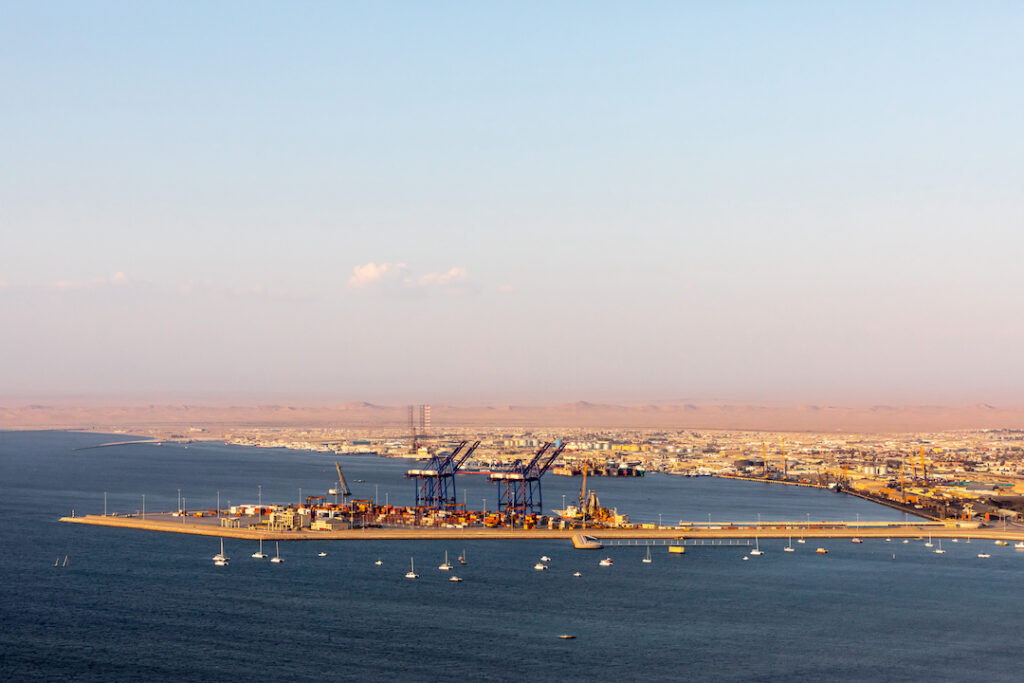
WALVIS BAY LAGOON
The Walvis Bay Lagoon takes pride of place as a scenic attraction in the Walvis Bay area. The tranquil body of water, its natural beauty accentuated by thousands of flamingos gathering at the rich feeding grounds, is over 3000 years old. The lagoon has been silting up for hundreds of years, a process hastened by man’s activities. Because of its value nationally and internationally as a wetland area, it was designated as a RAMSAR site in 1995, RAMSAR being a convention on wetlands held in 1971 in Ramsar, Iran. The lagoon is regarded as the most important wetland for coastal birds in Southern Africa. Wading birds including Lesser and Greater
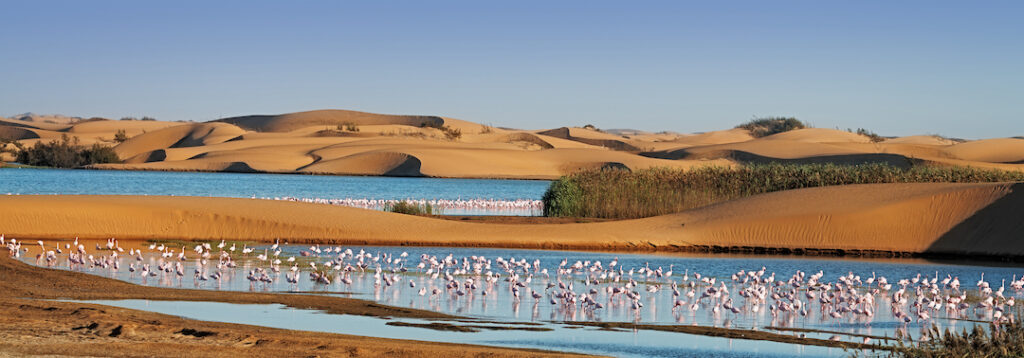
The Walvis Bay lagoon is regarded as the most important wetland for coastal birds in Southern Africa.
Accompanied by a local guide, visitors can go on self-drive township tours. Various options for sightseeing can be included in the package. Lasting from three to four hours, the tour includes stops at the Kuisebmond Market Hall; the kindergarten in Daniel Maxuilili Street where children present a special show; the Multi-purpose Community Centre; and Tutaleni Village. The tour ends at the Mola Mola shebeen, where traditional foods such as mopane worms, makaka, oshifima porridge and beans can be sampled. The Tutaleni Village and Relocation Project in the township is an example of how the problem of overcrowding is solved by means of an innovative housing concept. More than 800 families have been relocated successfully and now enjoy amenities that previously seemed unattainable. The Tutaleni Village remains municipal property and will be treated as an ongoing project sustained through the joint efforts of the resettled communities, the local authority and the private sector.
Options in Walvis Bay include The Raft restaurant on the Walvis Bay Lagoon and Crazy Mama’s Restaurant for pizza lovers. The Fairway Restaurant & Bistro in the Walvis Bay Tourism Centre serves breakfast, lunch and homemade cakes, sundowners and pizza. Other places to eat are Anchors @ the Jetty, Buffalo’s Restaurant, Bonaroma Restaurant, Willi Probst Bakery, Restaurant & Boulevard Café, Steve’s Take Away andO’Heilie’s Steakhouse. The Lemon Tree Deli offers health sandwiches, sushi, fresh fish, and a selection of other seafood delicatessen. See the Walvis Bay Waterfront for an eclectic selection of eateries.
The Walvis Bay Waterfront is abuzz with activity. Apart from the unique ocean atmosphere – with pelicans and other seabirds entertaining visitors with their playful antics – and operators offering ocean cruises, there is a wide selection of restaurants. Pirate’s Wreck Sports Bar is a popular sundowner spot, and the Jetty Shoppe sells a wide variety of gift items. Dockside Seafood and Grill has a rustic atmosphere and a great selection of light meals and drinks. Local crafters also sell their goods at the Waterfront.
Midway between Walvis Bay and Swakopmund is Langstrand. Established by the Walvis Bay Municipality, the neighbourhood’s main beach features tidal pools and ideal swimming conditions. The neighbouring Dolphin Park Recreation Resort has its own chalets, swimming pool, hydroslide and barbecue facilities. Dune 7, on the outskirts of town, is the highest dune in the area. Palm-tree- shaded facilities for day camping and barbecues are ideal for family entertainment.
The angling potential along the coast is particularly good. An angling area favoured by locals is Paaltjies, which consists of four angling spots south of the town. The ‘paaltjies’ are navigational beacons used by commercial fishermen. The first ‘paaltjie’ can be reached by ordinary vehicle, but a 4×4 is required to reach the other three further south.
The Walvis Bay Lagoon is ideal for windsurfing, boating and regattas organised by the Yacht Club, in which Hoby Cats, Fireballs and catamaranscompete. A tour operator offers ski- boat trips for shark, bottom and game fishing. Beach-fishing trips in 4×4 vehicles along the coast specialise in shark fishing. Boating day trips are enjoyable pleasure excursions.
If you’d like to lay your hands on some fresh fish, a good option is to catch it yourself by booking an ocean safari, or going on a fishing expedition along the beach.
At the end of Union Street in Walvis Bay, bordering the desert and tourist area, the Walvis Bay Tourism Centre is a welcoming ‘one-stop shop’. The Centre is a novel concept, with much to offer, such as accommodation in four bungalows, a restaurant, Internet facilities, pro-golf shop and driving range, Information Desk, Levo Tours offices, and Photo Ventures – which offers photographic and other tours.
Tel (+264 64) 20 0606
SANDWICH HARBOUR
The lagoon at Sandwich Harbour, situated 48 km south of Walvis Bay at the foot of towering ivory- coloured dunes, is a spectacular and sought-after destination. The lagoon, referred to in old texts as Sandfisch Haven, is a former bay that silted up over the years. Today especially ornithologists, photographers and nature lovers visit Sandwich.
The Sandwich area has a strange mystique, enhanced by the legend that buried somewhere in the dunes above the high-water mark is a ship with a rich cargo of ivory, gold and precious stones. This treasure has been searched for by many fortune hunters, but to date has eluded all. The lagoon is fed by fresh water seeping from an inland aquifer, and it is a sanctuary for large numbers of coastal and freshwater birds. It is also an important breeding ground for a variety of fish species. Sandwich Harbour was proclaimed a RAMSAR site in 1995. It is one of five such protected wetlands in Namibia.
Permits to visit Sandwich are obtainable from the MEFT offices in Swakopmund, Walvis Bay, Sesriem and Windhoek. Please note that Sandwich is accessible only by 4×4 vehicles; that in certain areas angling and vehicles are prohibited; that angling is not allowed from 25 January to 15 April; and that overnight camping is not allowed here.
HENTIES BAY
In 1929, Major Hentie van der Merwe, a motorcar dealer who operated from Kalkveld, discovered a fresh- water spring in an old delta of the Omaruru River while on a rhino-hunting expedition in the desert. He fell in love with the surroundings and for years it was his private haven to which he escaped every December.
Henties Bay has since become a popular proposition for holiday and retirement property investments, due to the relatively affordable property prices and the town’s popularity as a holiday resort. Its peaceful atmosphere and remote setting on the Skeleton Coast is one of its greatest assets.
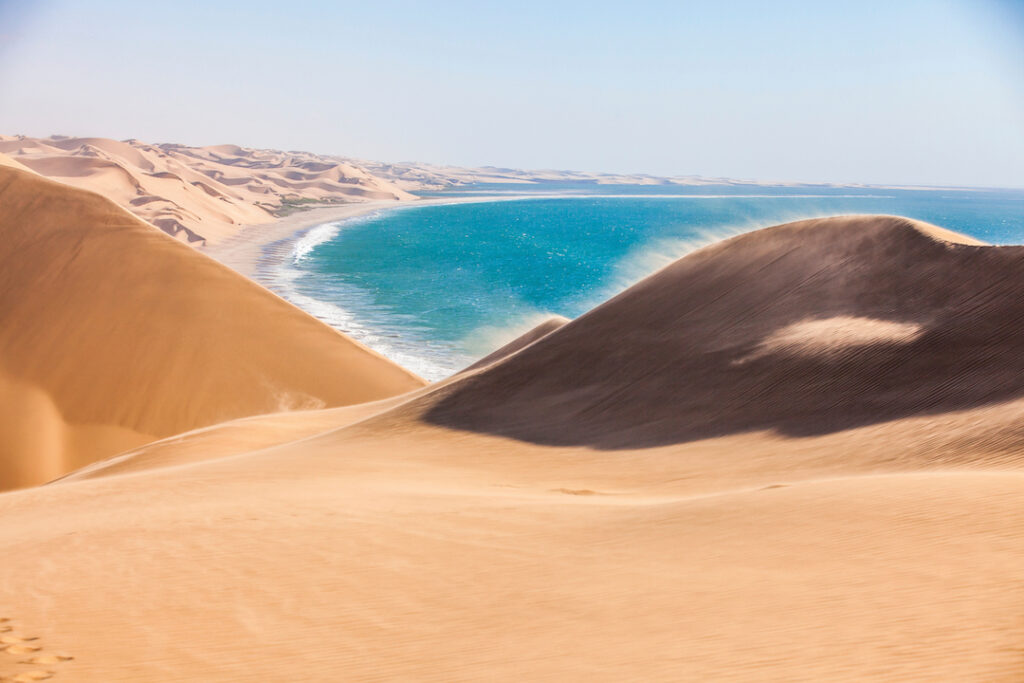
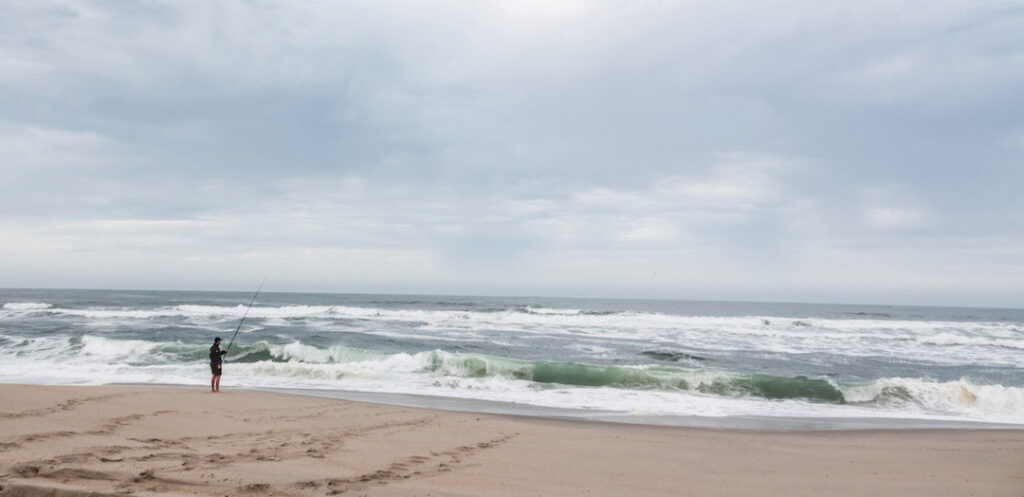
Henties Bay offers the Fishy Corner Seafood Restaurant & Take-away, Legends Pub & Grill, Desert Sands lapa bar & braai, De Duine Hotel,Pirate’s Cove sports bar and pizzeria, the Skubbe Bar and more. Good options for coffee and cake are the Coffee House, Misty Bay Café & Coffee Shop, and NamPie coffee shop.
A peculiar phenomenon is a fresh-water fountain situated almost on the beach in the so-called Valley, an old tributary of the Omaruru River. Apparently this fountain served as a lifesaver to many early explorers, one being Henties Bay’s own Major Hentie van der Merwe.
One of the biggest events in Henties Bay is the annual Henties Festival in August each year which attracts visitors from all over Namibia, South Africa and even overseas. The annual Christmas Market, Angling Bonanza, and Touchies in December are events that have a high priority on the yearly calendar.
Although shore fishing is still Henties Bay’s number-one attraction, there is much to do for those who don’t fish. The Jakkalsputz walking trail leads through the beautiful Solitude Bay with its rocky shores and hummock dunes stabilised by coastal desert plants adapted to grow in harsh conditions.
The Omaruru River Walking Trail, a long hike along the riverbed and across the Namib Desert plains, gives hikers an experience of the harsh but beautiful desert environment. Remember to take drinking water along.
The Henties Bay Golf Course is laid out in the Valley. It is a nine-hole course, extending over 2.7 km, and has well-tended grass greens and tees, while the fairways are being planted with grass, which will turn it into a lush green spot in the riverbed. Golf competitions are organised regularly, especially during the December holiday season.
While quad-bikes provide fun on the beach, they should be used responsibly and with due consideration to residents and other holidaymakers. Areas specifically designated for their use are 10 km upstream in the Omaruru River environs and the beach either side of the residential areas. When riding on the beach, please take other people into consideration and be on the lookout for children and pets, especially during the holiday season. Quad-bikes are not allowed north of the Omaruru River and east of the C34 or in front of residential areas and campsites.
Situated in the Dorob National Park (the former National West Coast Recreation Area), Henties Bay offers the nature lover an attractive albeit sensitive natural environment with diversified fauna and flora and many sites of interest. Some of the biggest and best specimens of the renowned Welwitschia mirabilis grow among the hills of the Messum Crater. This curious plant – some specimens are estimated to be at least 1 500 years old – is endemic to the Namib Desert, from Swakopmund northwards to Mossamedes in Angola.
Desert-adapted game species seen on the desert plains and in the dry watercourses include steenbok, springbok, gemsbok and Hartmann’s mountain zebra. Ostrich are commonly seen in southern Damaraland.
This wonderland can be explored along 4×4 routes to destinations such as the Messum Crater, Brandberg West, the Ugab Menhir, Spitzkoppe, Omaruru River and various mineral mines. All roads are signposted and graded. An A2 satellite map with all the routes can be bought from the Henties Bay Tourist Office. Please note that permits are required for trails in and traversing the Dorob National Park.
Lichen fields can be viewed at Mile 30 south of Henties Bay, just north of the turnoff to the Cape Cross Seal Reserve and on the way to the Messum Crater. Visitors are asked not to leave the existing roads, but to park their vehicles next to the road and inspect these interesting organisms on foot. If a little water is sprinkled on them, they magically come to life.
The Damara Tern, a bird endemic to Namibia that makes its nest in shallow scrapes among the saltbushes (ganna) on the gravel plains, is especially threatened by off-road driving. The nesting grounds of these diminutive birds are between the coastal road and the sea, and there is an important breeding colony just north of the Omaruru River. If you leave the road to reach the beach, stay on the existing tracks.
The Omaruru River offers opportunities for walking, quad-biking and 4×4 driving, and has excellent picnic sites. The Old Fig Tree is a well- known and popular picnic site not far from Henties Bay. You can also drive up the sandy riverbed past the Omdel Dam to Skoenklip and exit the river at Lêwater to follow the route to the Spitzkoppe. The Omdel Dam – mostly dry – offers picnic sites, a variety of bird species, especially when there is water in the dam, and interesting desert-adapted plants. To reach Omdel Dam, take the C35 to Uis for ±27 km, then turn right and follow the narrow track for 14 km to the Omdel Dam wall. Alternatively, the course of the Omaruru River can be followed in a 4×4 to reach the dam.
CAPE CROSS SEAL RESERVE
The Cape Cross Seal Reserve, with a surrounding area of 60 km2 consisting of flat gravel plains and the rocky outcrop where the seals gather, was proclaimed in 1968 to protect the biggest and best known of the 23 colonies of Cape fur seals that breed along the Namibian and western South African coast. The reserve is situated approximately 130 km north of Swakopmund. From January until the end of June the reserve is open on weekdays from 08:00–17:00; from the beginning of July until the end of November from 10:00–17:00; and in December again from 08:00–17:00. On weekends the reserve is open from 08:00–17:00. For further information contact the Ministry of Environment, Forestry and Tourism at Cape Cross, Tel: 064 69 4037. It was here that the Portuguese navigator, Diogo Cão, on his second expedition to Africa south of the equator, erected a stone cross in 1486. Two replicas of this cross can be viewed at the site where the original one was erected. Germany has undertaken to return the original padrão to Namibia.
A small lichen reserve containing a relatively large variety of species can be viewed from close by. Bird islands off the coast are also protected.
The South African (Cape) fur seal, Arctocephalus pusillus, is the largest of the world’s nine fur-seal species. As many as 210 000 of these animals gather at Cape Cross at any one time during the November/December breeding season.
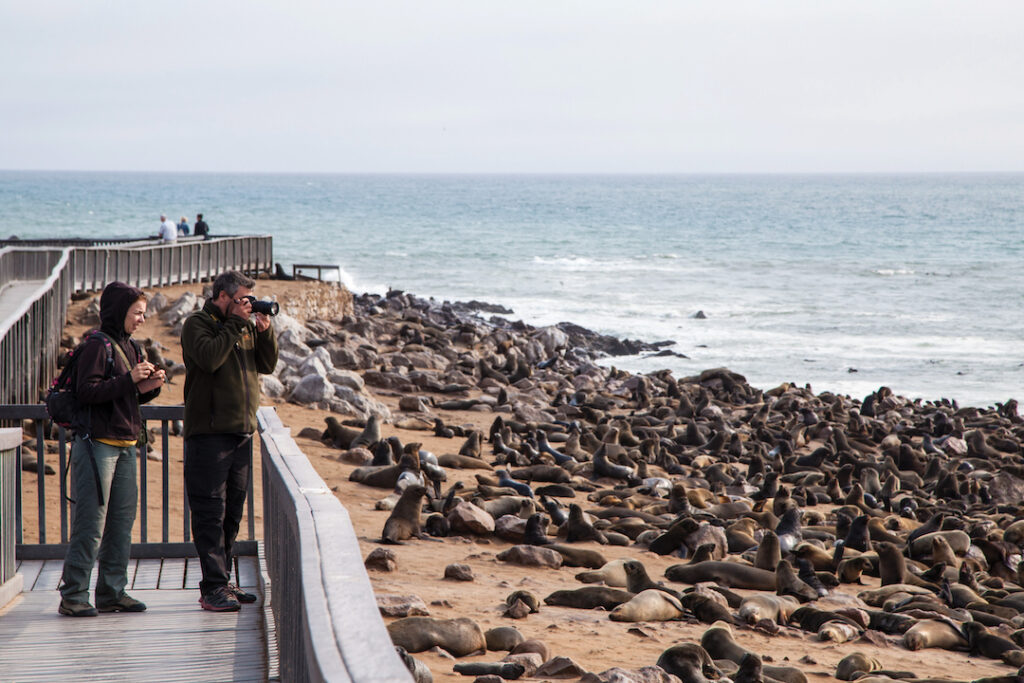
SKELETON COAST PARK
The Skeleton Coast Park, proclaimed in its present form in 1971, extends from the Ugab River for 500 km up to the Kunene River in the north, covering an area of 16 845 km2. It protects about one third of Namibia’s coastline.
The landscape in the park ranges from sweeping vistas of windswept dunes, to rugged canyons with walls of richly coloured volcanic rock and extensive mountain ranges. Over a hundred species of lichen grow on the plains and west-facing mountain slopes, changing colour and becoming soft and leathery to the touch when the coastal fog generated by the cold Benguela Current pushes inland. Animals occurring on the plains are gemsbok, springbok, jackal, ostrich and brown hyaena, while desert- adapted elephant and even black rhino, lion and giraffe roam up and down the dry river courses. The northern section of the Skeleton Coast Park is a tourism concession area that is restricted to fly-in safaris and guests to Shipwreck Lodge north of Möwe Bay. Of special interest are the clay castles of the Hoarusib,
the saltpans near the Agate Mountain and the seal colony at Cape Frio. The southern section – between the Ugab River and just north of Terrace Bay – is accessible to the general public staying at Terrace Bay and Torra Bay. Because of the ecological sensitivity of the coastal desert, the entire park is managed by the MEFT as a wilderness area.
A day permit to drive directly through the southern section of the park is obtainable from the MEFT Tourist Office in Swakopmund, as well as at the Ugab and Springbokwasser gates. Visitors driving through need to enter before 15:00 and leave by 17:00 and may not visit Terrace Bay or Torra Bay along the way. Overnight visitors must be in possession of a valid reservation advice for Terrace Bay or Torra Bay and arrive at the checkpoints at the Ugab Mouth and Springbokwasser gates no later than 15:00 and leave from these points no later than 17:00.
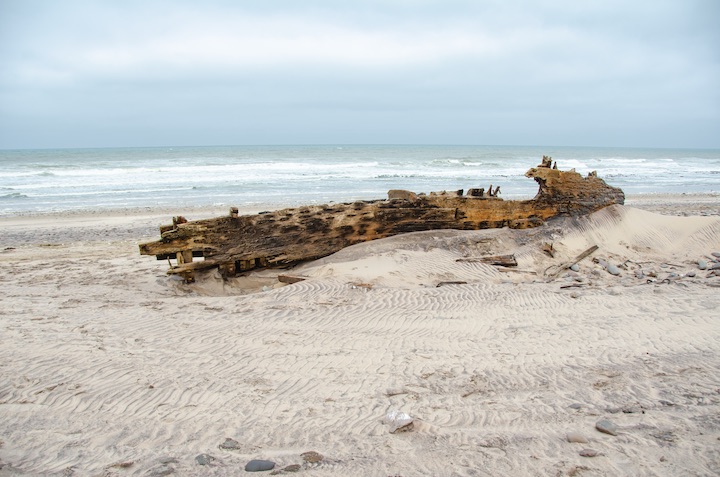
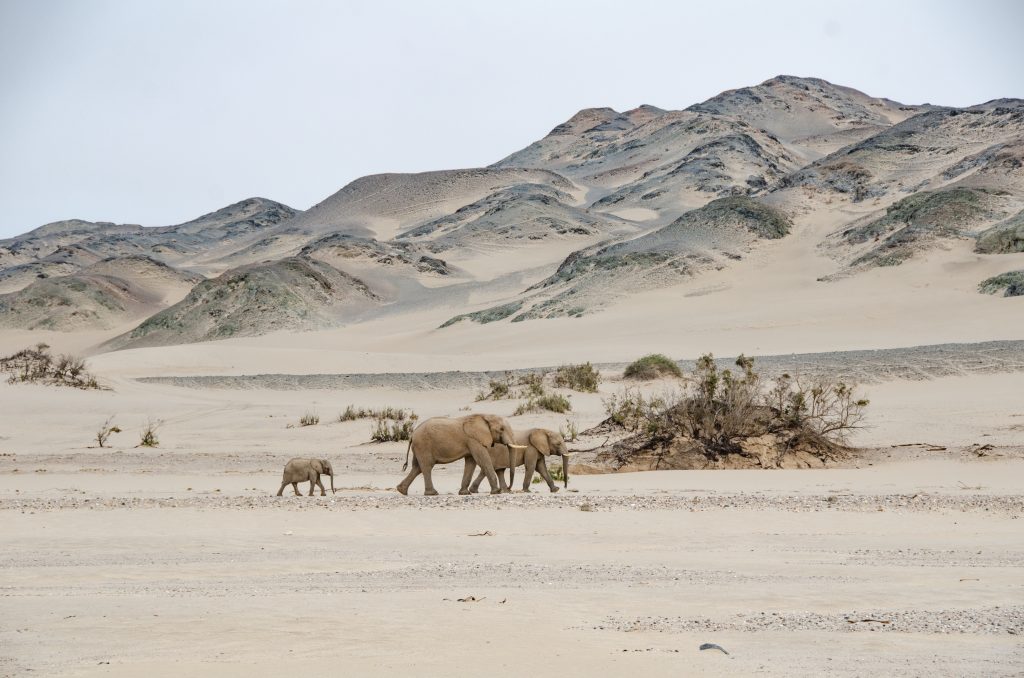
Accommodation
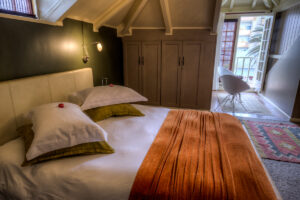
Villa Margherita
Villa Margherita is a luxury boutique hotel in the heart of Swakopmund. Margherita stands as a fusion of contemporary art and historic colonial buildings, with beautifully manicured gardens and stylish rooms, most of them having a private lounge area. This glamourous lady offers seclusion and personalised service.The “Charming House” offers ten romantic suites & luxury
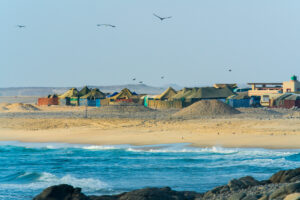
Torra Bay
Torra Bay is a seasonal fishing retreat, situated inside the Skeleton Coast National Park on the Atlantic coast. Open only in December and January, Torra Bay is famous in the angling circle due to the variety and quantity of fish that come down the Atlantic current. Other activities include bird watching, walking along the beach,
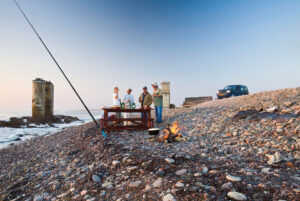
Terrace Bay Resort
Terrace Bay is an angler’s paradise offering an exceptional experience inside the famous Skeleton Coast National Park along Namibia’s northwestern coastline. The resort is located on the coast, set in an undisturbed and peaceful spot, surrounded by the majestic dunes of the northern Namib Desert. You can easily venture into the nearby Uniab River Delta,
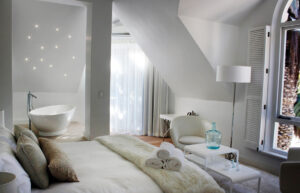
Swakopmund Luxury Suites
Nestled in the heart of Swakopmund, walking distance from the beach, trendy cafés, restaurants, as well as popular tourist sights, Swakopmund Luxury Suites is the only place you need to book to ensure a memorable visit in this beautiful coastal town. Each of their 20 suites is designed for utmost comfort – ideal for the
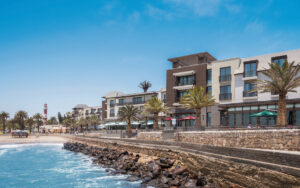
Strand Hotel Swakopmund
With its extensive and entertaining Restaurants, Bars, Lounges, Deli, sea facing Terraces and Conference & Banqueting Centre the Strand Hotel is the social epicenter of Swakopmund, Namibia. Uniquely located on the iconic and historic Swakopmund Mole and surrounded on three sides by the Southern Atlantic Ocean its 125 rooms and suites offer the finest uninterrupted
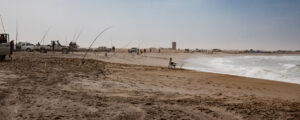
Mile 72, Mile 108, Jakkalsputz
The coastline along the Dorob National Park is a very popular attraction for fishing and holiday-makers in general. NWR’s Mile 72, 108 and Jakkalsputz offers accommodation within the park that is in close proximity to the ocean and perfectly situated from where to explore the park. Mile 72 and 108 provide a choice of either
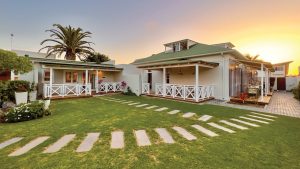
Brigadoon Boutique Guesthouse
Brigadoon Guesthouse offers spacious, well-equipped rooms to accommodate two people, or families, in style and comfort, allowing an opportunity for total relaxation, away from the hustle, bustle and buzz of Namibia’s most vibrant town. Each room overlooks the lush garden from its own private patio deck where guests always appreciate their individually served breakfast. Visit Brigadoon Guesthouse Book your Stay


